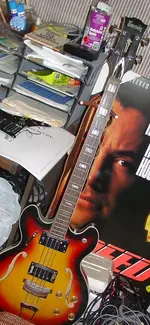rayc
retroreprobate
https://www.youtube.com/watch?v=jLOTAJQF0Fo
Scott Walker's Montague Terrace (In Blue) is the above example but the bass tone is similar in his classic 4 albums.
I doubt he plays the bass on these (though he was Scott Bros bassist) but I love the tone.
NOT, I avow, a tone I'd use on most of my own stuff, but one that I'd like to have in the haversack if I felt I'd like to try it on.
I have an old Emperador semiacoustic bass with flat strings; what else do I need?
Compression?
Tube amp?
Foam?
Sponge?
Scott Walker's Montague Terrace (In Blue) is the above example but the bass tone is similar in his classic 4 albums.
I doubt he plays the bass on these (though he was Scott Bros bassist) but I love the tone.
NOT, I avow, a tone I'd use on most of my own stuff, but one that I'd like to have in the haversack if I felt I'd like to try it on.
I have an old Emperador semiacoustic bass with flat strings; what else do I need?
Compression?
Tube amp?
Foam?
Sponge?



